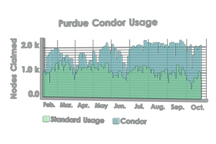
Scientists benefit from Purdue's unused computer cycles
WEST LAFAYETTE, Ind. — Computing cycles are the fuel that powers science, and computer experts at Purdue University have found a way to double their mileage.

|
At Purdue, computers are in use almost continuously, thanks to an innovative approach to distributed computing that sends work to the computers day and night.
"We're harvesting waste cycles and putting them to good use," says Gerry McCartney, Purdue's interim vice president for information technology and chief information officer.
Purdue has enough unused cycles that, through a project funded in part by the National Science Foundation, it is powering scientific research at other institutions, as well.
The university has more than 4,300 computers of all sizes — from desktop machines used by students to do homework and check e-mail, up to large, powerful research computers — that are linked together in what is known as a pool. If a computer anywhere in the pool stops working, even for a few seconds, jobs are sent to it for processing.
To capture available computer cycles, Purdue uses open source software called Condor to direct jobs within the pool. The computers in the Condor pool at Purdue are used roughly 45 percent of the time for their intended purpose and 45 percent for Condor-assisted projects. They are only idle 10 percent of the time.
Miron Livny, a professor of computer science at the University of Wisconsin, first developed Condor in the 1980s. He says that Purdue has more machines running Condor than any other university.
"Other campuses should follow Purdue's leadership," Livny says. "I believe this is the right way for us to move science forward. We should get organized and get our resources together, and then go out on the national level and share resources with other institutions."
The process is similar to the international SETI@home project, which uses personal computers on the Internet to analyze radio signals captured by telescopes to search for extraterrestrial life. In this case, however, Purdue makes its unused computing cycles available to other researchers across the nation via a national research network, the NSF-funded TeraGrid.
Michael Deem, Rice University's John W. Cox Professor of Biochemical and Genetic Engineering and a professor of physics and astronomy, has used nearly 1 million hours of computer cycles from Purdue to catalog the chemical structure of compounds called zeolites. These chemical catalysts are used in everything from laundry detergent (25 percent of powdered laundry detergent is made up of zeolites) to refining gasoline.
Deem aims to identify and categorize as many of these structures as possible so that chemical engineers can select the exact zeolite they need. This is just the kind of high-throughput job that works well on Purdue's distributed computing system.
"The throughput is much higher there than I can get locally because of the large size of the Condor pool at Purdue," Deem says. "Purdue is doing a great service to the scientific community by providing this resource."
McCartney says that sharing resources, such as unused computing cycles, boosts scientific discovery.
"Our ability to harness waste computing cycles, and then to offer them to other scientists who can make use of them, shows that the Internet is finally working the way it was supposed to."
Christoph Hoffmann, director of Purdue's Rosen Center for Advanced Computing, says distributed computing using systems such as Condor are more effective on some types of scientific research than others. Condor is high-throughput computing, millions of a simple jobs can be given over to a large number of machines in a process also known as serial computing.
"It is good for bioinformatics, animation rendering, identifying chemical structures, structural biology, high-energy physics — anything where you need to do a similar task over and over," Hoffmann says.
Purdue also is using Condor on the TeraGrid to assist with an international experiment in particle physics. CERN, the European Organization for Nuclear Research, is building the world's largest scientific instrument, the Large Hadon Collider. Purdue is one of 100 Tier-2 institutions assisting with the data that this instrument will produce.
Hoffmann says tools like Condor allow the scientific community to pool and leverage resources.
"By using distributed computing, we can put it on the grid and use computers around the world to process the data instead of having a stadium full of computers at CERN."
Purdue's Rosen Center for Advanced Computing publishes a daily graph showing the university's Condor usage.
Writer: Steve Tally, Information Technology at Purdue, (765) 494-9809, tally@purdue.edu
Sources: Gerry McCartney, (765) 496-2270, mccart@purdue.edu
Miron Livny, (608) 262-0856, miron@cs.wisc.edu
Michael Deem, (713) 348-5852, mwdeem@rice.edu
Christoph Hoffmann, (765) 494-6185, cmh@cs.purdue.edu
Purdue News Service: (765) 494-2096; purduenews@purdue.edu
GRAPHIC CAPTION:Purdue University has been able to double the output of nearly 5,000 of its computers by using a system that captures computer cycles when the computers aren't being used. The Purdue system includes the open source software Condor and, in many weeks, the amount of computing done using the Condor system (shown in blue on the chart) equals or exceeds the work being done on the computers by their regular users. (Purdue University graphic/Ty Filby, Information Technology at Purdue)
A publication-quality graphic is available at https://www.purdue.edu/uns/images/+2006/condorgraph.jpg
To the News Service home page